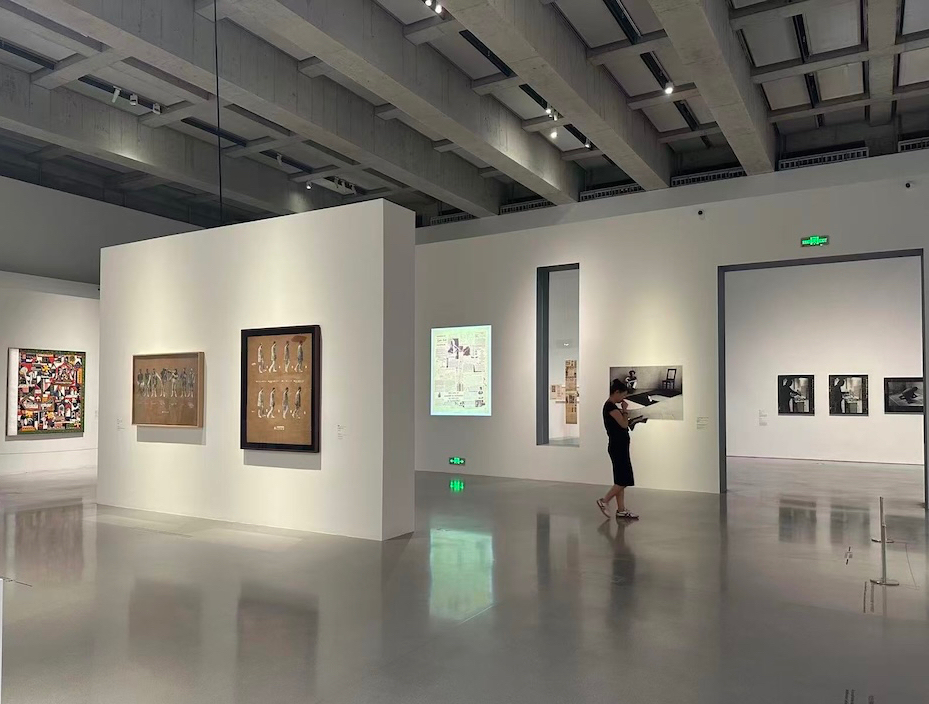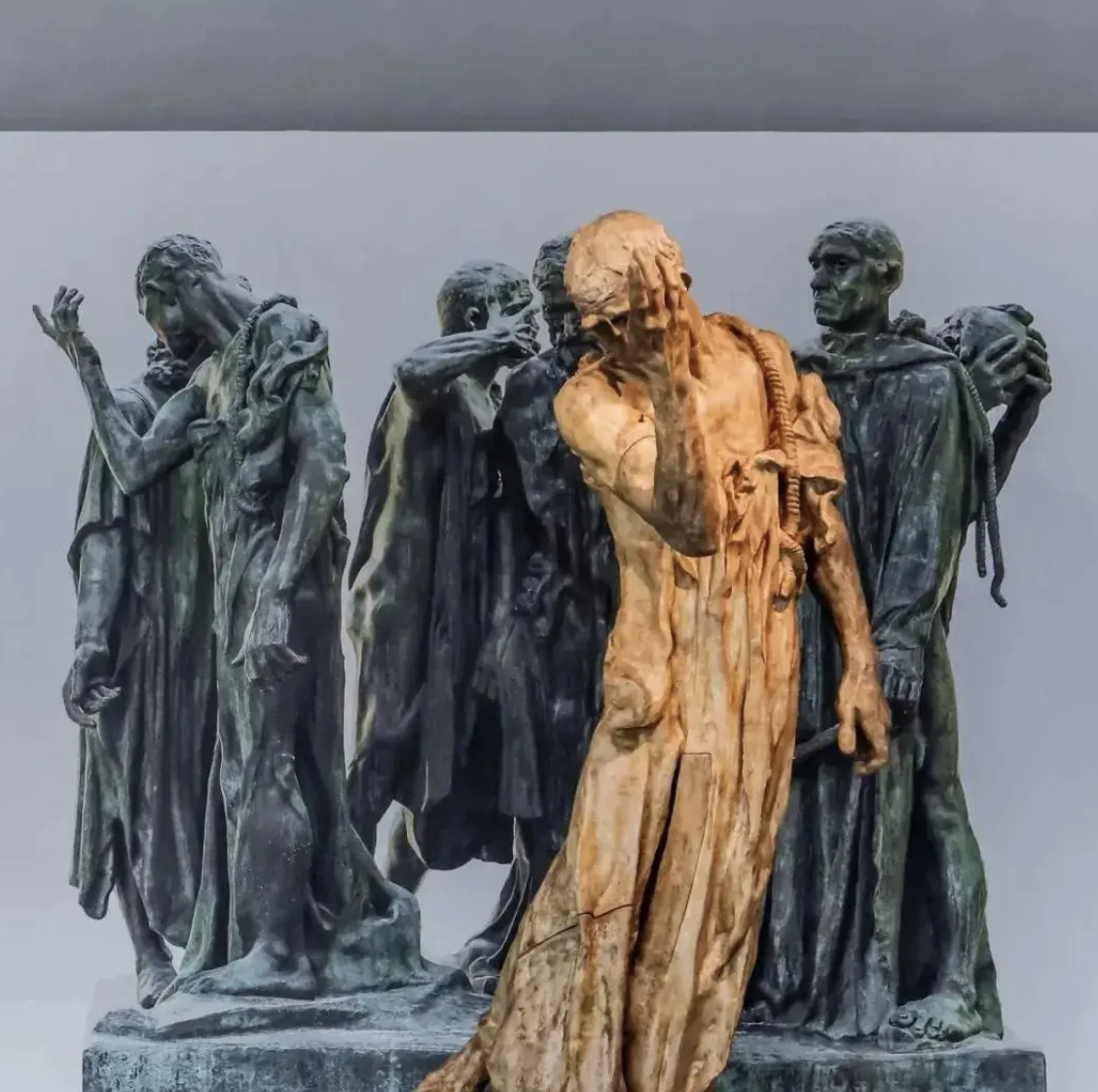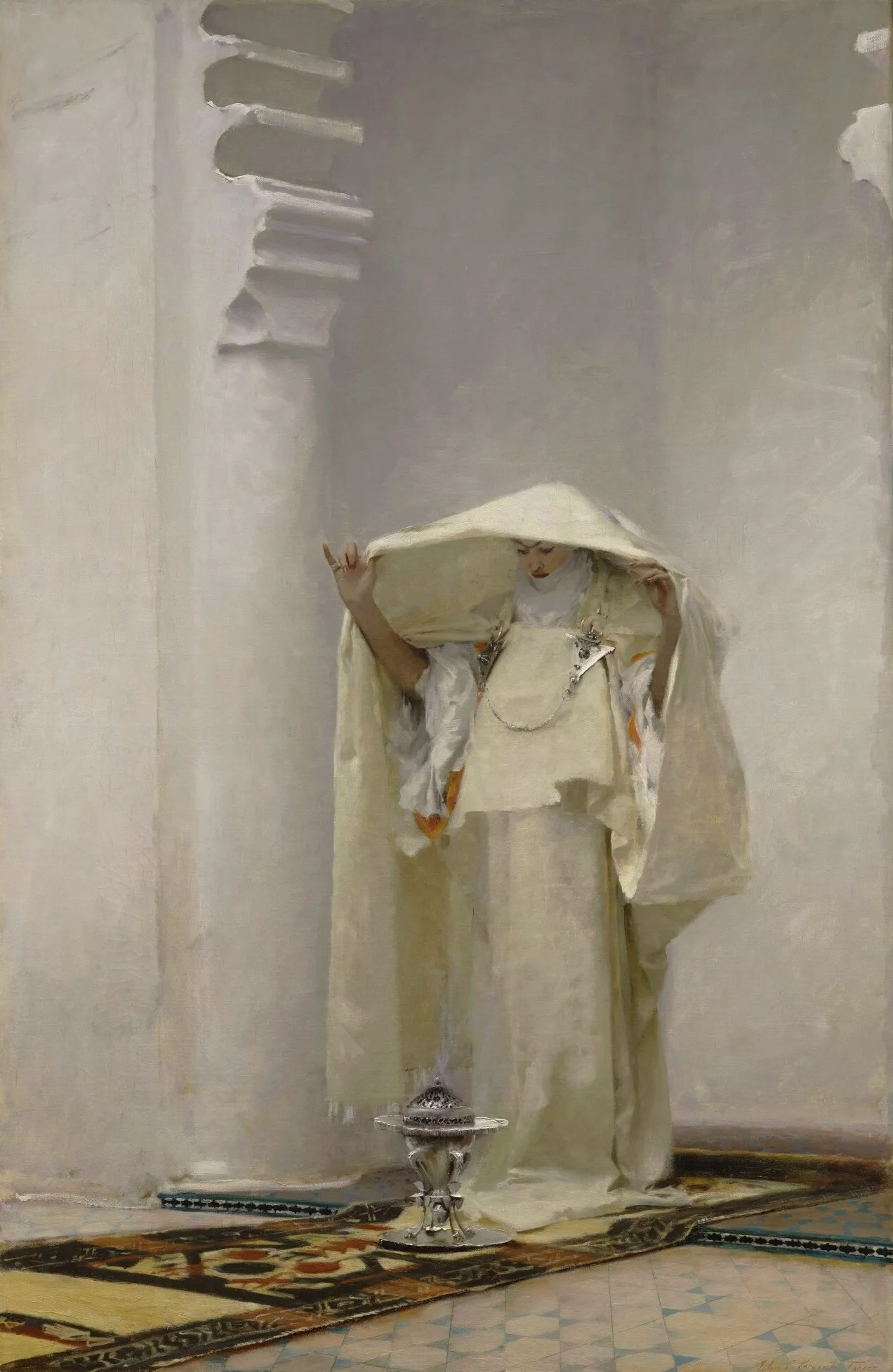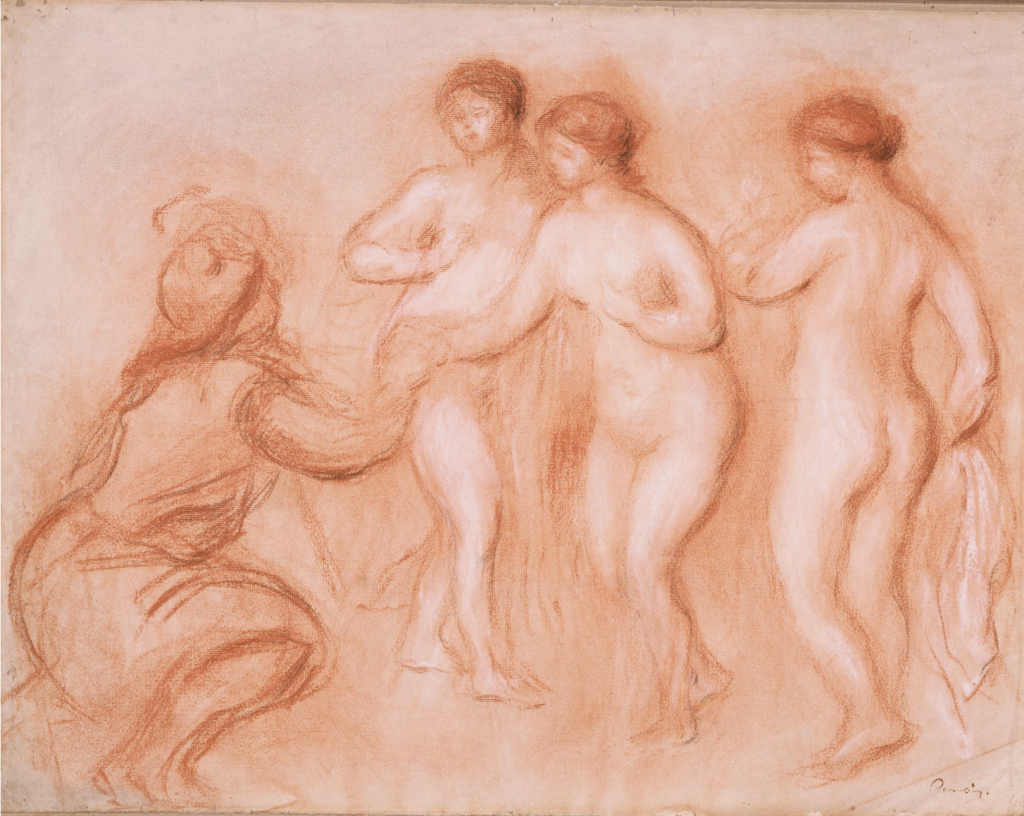
This week, The Paper's "Global Exhibitions" spotlights the sketches of several Western masters. A New York exhibition of Renoir's drawings showcases the artist's style from different periods, including a preliminary study for his famous work, "The Bather." An exhibition of drawings by Italian Renaissance masters opened in Edinburgh, showcasing over 80 drawings by 57 artists.
Two exhibitions in Japan are also worthy of attention. In addition to the Song and Yuan Dynasty Buddhist painting theme exhibition at the Kyoto Museum in Japan, the newly presented "Shosoin Exhibition" at the Nara National Museum is celebrating its 77th time this year, displaying a total of 67 pieces (sets) of Shosoin collections, 6 of which are exhibited for the first time.
Renoir's sketches
Exhibition period: October 17, 2025 - February 8, 2026
Location: The Morgan Library and Museum, New York

Study for The Great Bather by Renoir

Landscape, Autumn Effect, circa 1885–86
This exhibition traces Renoir's life and artistic career and is the first exhibition dedicated to Renoir's works on paper in over a century. Over one hundred of Renoir's works are on display.
Renoir produced a remarkable but little-known body of drawings, pastels, watercolors, and prints.
Colin Bailey, director of the Morgan Museum and curator of the exhibition, said that because they are works on paper, they will not be permanently exhibited in any institution. The works from this decade offer a real sense of his development and the different styles he developed throughout his career. Renoir was born in Limoges, in southwestern France, in 1841 and grew up in Paris. He was deeply influenced by Gustave Courbet and befriended fellow artists such as Claude Monet and Alfred Sisley – who later helped define Impressionism. In 1869, while painting with Monet on the banks of the Seine, Renoir experimented with brighter tones and lighter brushstrokes, and from that point on, his new style emerged.
"Rembrandt: Black and White Masterpieces - Prints from the Rembrandt House Museum" Touring Exhibition
Exhibition period: October 24, 2025 to January 11, 2026
Location: Gibbs Museum of Art in Charleston (first stop in the United States)

Madonna and Child with a Cat and a Snake, Rembrandt van Rijn (1654), Rembrandt House Museum, Amsterdam
The exhibition, co-curated by the American Art League and the Rembrandt House Museum in Amsterdam, features 58 works: 44 by Rembrandt and 14 by artists influenced by him in the 19th and 20th centuries. The exhibition explores Rembrandt's centuries-long influence on printmaking, including works by Picasso, Whistler, and others.
This presents Rembrandt's artistic context and reveals his unique innovations in repeated experimentation with etching techniques, tonal effects, and dramatic thematic expression.
From his earliest etchings, Rembrandt created original compositions tailored to the characteristics of the print medium, resulting in a wide range of print sizes, from general sketches to intricate and elaborate works.
Depicting the Italian Renaissance
Location: King's Gallery (Edinburgh, Scotland)
Exhibition period: October 17, 2025 to March 1, 2026

Raphael (1483-1520), The Three Graces, circa 1517-18

Leonardo da Vinci (1452-1519), Head of a Young Man, circa 1510
The exhibition features more than 80 sketches by 57 art masters, including Leonardo da Vinci's dragon-shaped clothing design manuscript. It is the largest exhibition of Italian Renaissance sketches in Scotland in more than half a century.
The exhibition will not only highlight the artistic value of these works, but will also showcase the continuity and vitality of sketching as an art form in the contemporary era through an on-site artist residency program. Two young artists from the Edinburgh College of Art (ECA) will continue to create in the exhibition hall and interact with the audience, encouraging visitors to try sketching themselves.
In addition, family workshops, gallery night tours, lectures and guided tours will be held during the exhibition. Through yoga, storytelling, live painting and other methods, audiences of different ages will have a deeper understanding of the diversity and creativity of Renaissance sketches.
This exhibition is not only a review of art history, but also a creative dialogue across time and space, inviting the audience to enter the thinking and style of the Renaissance masters.
Life Cannot Stop: Rauschenberg Centennial Retrospective
Exhibition period: October 10, 2025 - April 5, 2026
Location: Guggenheim Museum, New York, USA

Barge, 1962-1963, oil and silkscreen ink on canvas

Untitled, 1963, oil, silkscreen ink, metal, and plastic on canvas
This exhibition brings together over ten iconic works from the Guggenheim's collection, along with significant works on loan from the Robert Rauschenberg Foundation, to highlight the artist's bold use of materials and media. Coinciding with the centennial of Rauschenberg's birth, the exhibition joins global commemorations in honoring this boundary-pushing, experimentalist, and profound influence on contemporary art.
The centerpiece of the exhibition, Barge (1962–63), a monumental 32-foot-long silkscreen painting completed by the artist in approximately 24 hours, is the largest work in a series of approximately 80 “silkscreens” made between 1962 and 1964. This landmark work returns to New York after an absence of nearly 25 years.
The Pazzi Conspiracy: Power, Violence, and Art in Renaissance Florence
Exhibition period: October 24, 2025 to September 20, 2026
Location: Bode Museum, Germany

Sandro Botticelli, Portrait of Giuliano de' Medici, 1478. Staatliche Museum, Berlin.

Cardinal Raffaele Sansoni Riario, Andrea Brenio, Rome, circa 1478 © Staatliche Museum, Berlin
In 1478, Pope Sixtus IV conspired with the Pazzi family, a prominent Florentine banking family, to assassinate Lorenzo de' Medici and his brother Giuliano during Easter Mass in the Cathedral of Santa Maria del Fiore, intending to overthrow the Medici regime and reclaim the Papal financial and political control of Tuscany. Giuliano was fatally stabbed 19 times, while Lorenzo escaped wounded. The citizens quickly turned on the Medici, and the mastermind was hanged and his body dumped in the Arno River. The Pazzi family's estates were confiscated. The Pope's wars proved unsuccessful, and the Medici's reputation soared to new heights thanks to their bloody revenge and cultural diplomacy, ushering in the Renaissance's Golden Age.
This exhibition aims to retrace this event with the help of objects from the collections of the Berlin State Museums. The Numismatic Museum houses a collection of medals depicting key figures from the event, many of whose portraits are also now held in the Sculpture Collection and the Painting Gallery.
The 77th Shosoin Exhibition
Exhibition period: October 25th - November 10th
Location: Nara National Museum, Japan

Sangmu Ruanxian
Since 1946, the Nara National Museum in Japan has held the "Shosoin Exhibition" every autumn, showcasing selected items from the Shosoin Repository. This year marks the 77th edition. The exhibition showcases 67 items (sets) from the Shosoin Repository, six of which are on display for the first time. The exhibition encompasses musical instruments, furniture, clothing accessories, documents, and spices, and incorporates the latest research findings from the Shosoin Office of the Imperial Household Agency.
Exhibits include a "wooden painted red sandalwood backgammon board" (chessboard) made of exquisitely inlaid wood pieces, a "glass cup" with a deep indigo beauty, and "yellow incense" (fragrant wood), which is famous for the famous incense "Lanshedai".
Buddhist Paintings of the Song and Yuan Dynasties: Buddhas Journeying to Japan
Exhibition period: September 20 - November 16, 2025
Location: Kyoto National Museum, Japan

Statue of Peacock King at Ninna-ji Temple in Kyoto
"Song and Yuan Buddhist paintings" primarily refer to Buddhist paintings produced during the Song and Yuan dynasties in China (roughly the 10th to 14th centuries). Japan has long revered Buddhism, and a large number of Buddhist artworks were brought back from China by sea. These Song and Yuan Buddhist paintings were primarily introduced to Japan between the late Heian and Kamakura periods. Not only were they enshrined and admired in temples, they also became important models for Japanese artists, profoundly influencing Japanese culture.
This exhibition is the largest-ever themed exhibition of Song and Yuan Dynasty Buddhist paintings in Japan. Focusing on works inherited from Kyoto temples, it brings together over 100 paintings from these periods, held in Japan's most prestigious collections. Combining relevant works with historical documents, it comprehensively showcases the development, diverse perspectives, and later influences of Song and Yuan Buddhist painting, allowing viewers to deeply appreciate the remarkable charm of these works. Many of the exhibits are designated Important Cultural Properties, and most are housed in major Kyoto temples. Key exhibits include "The Peacock King," "The Three Figures of Amitabha," "The Five Hundred Arhats," and "Avalokitesvara with Monkeys and Cranes."
"Egyptian Gods" themed exhibition
Exhibition period: October 12, 2025 - January 19, 2026
Location: Metropolitan Museum of Art

"The God Thoth Walking", 332-30 BC, Metropolitan Museum of Art, New York
The exhibition aims to reveal the mysterious and often surreal qualities of ancient Egyptian religious art. For the ancient Egyptians, statues were not merely works of art but also vehicles for the gods to descend upon the earth, a crucial medium connecting mortals with the divine realm.
This is the largest special exhibition of ancient Egyptian art at the Metropolitan Museum of Art in over a decade, bringing together approximately 210 precious artifacts. The exhibits come from a wide range of sources. In addition to the Metropolitan Museum of Art's own rich collection (approximately 140 pieces), it also brings together exhibits on loan from world-class institutions such as the Louvre and the Boston Museum of Fine Arts.
In the exhibition, visitors will learn about 25 important gods of ancient Egypt, such as Horus, the patron god of the pharaoh with an eagle head and a human body, the goddess of war Sekhmet, the creator god Ra, the god of the underworld Osiris, etc., and explore the various roles these gods played in the daily life of ancient Egypt, and how they helped people cope with the uncertainty of life and eternal death.
Sargent: Paris Glitz
Exhibition period: September 23, 2025 - January 11, 2026
Location: Musee d'Orsay, France

In the Luxembourg Gardens
The exhibition brings together approximately 90 works, including paintings and drawings, many of which are being exhibited in France for the first time. A key highlight is Sargent's iconic and controversial "Portrait of Madame X," often called the "Mona Lisa" of the Metropolitan Museum of Art's American art collection.
In addition to classic portraits, the exhibition also displays his works depicting Parisian cityscapes (such as "In the Luxembourg Gardens"), travel sketches, and high society circles.
Sargent's works are famous for their exquisite craftsmanship, keen capture of light and shadow, and profound portrayal of the characters' psychology. You can see how he absorbed the influence of masters such as Velázquez and Manet, and integrated certain characteristics of Impressionism to finally form his own unique style.
Monet and Venice
Exhibition period: October 11, 2025 - February 1, 2026
Location: Brooklyn Museum, New York, USA
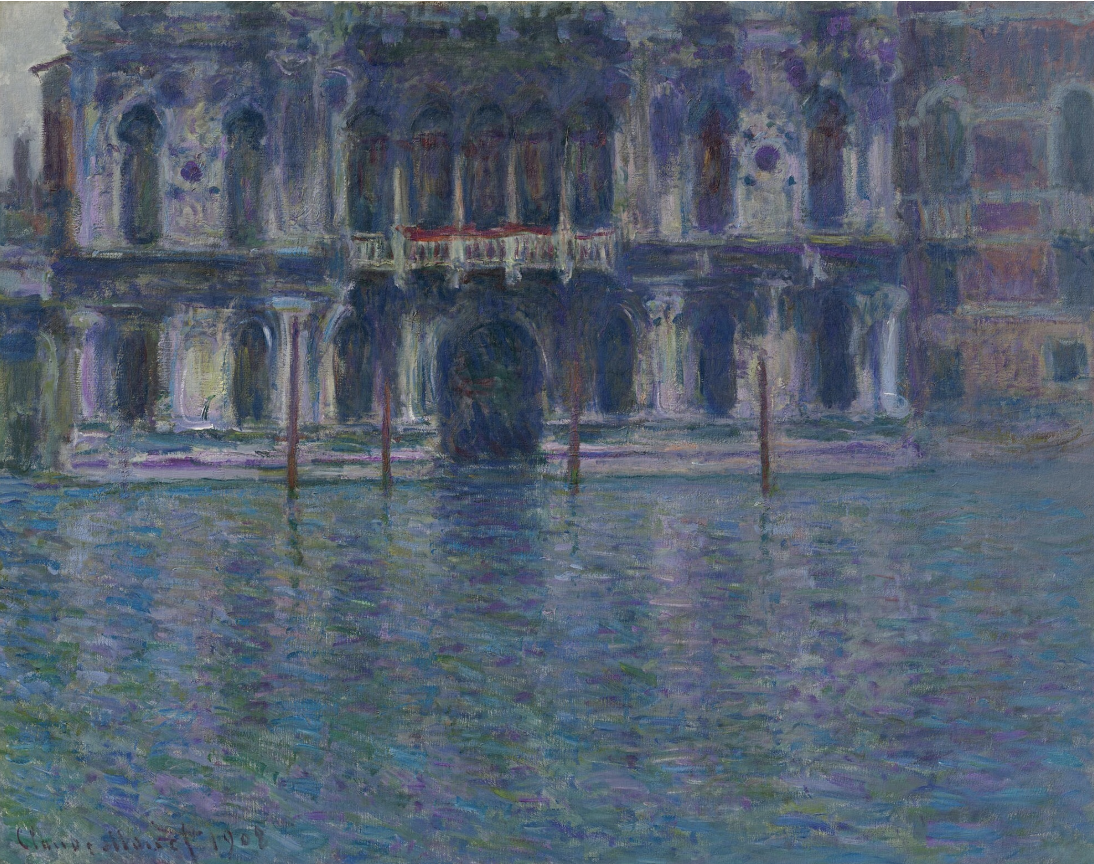
Palazzo Contarini, Monet, 1908
The largest Monet-themed exhibition in New York in nearly 25 years, this exhibition features over 100 artworks, books, and photographs, showcasing representative works from across Monet's career, as well as 19 paintings from his Venice series, including "Doge's Palace" from the Brooklyn Museum and "Grand Canal, Venice" from the Fine Arts Museums of San Francisco. Some of these works are on public display for the first time since 1912.
The exhibition features paintings from Monet's Venice series in dialogue with works by Canaletto, Paul Signac, John Singer Sargent, Pierre-Auguste Renoir, and others.
